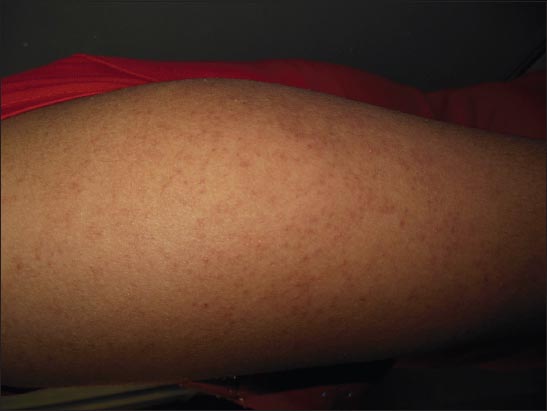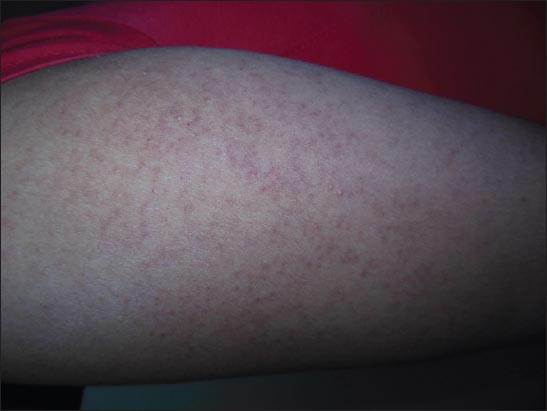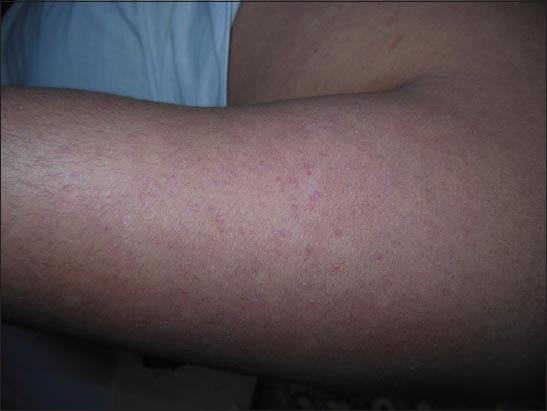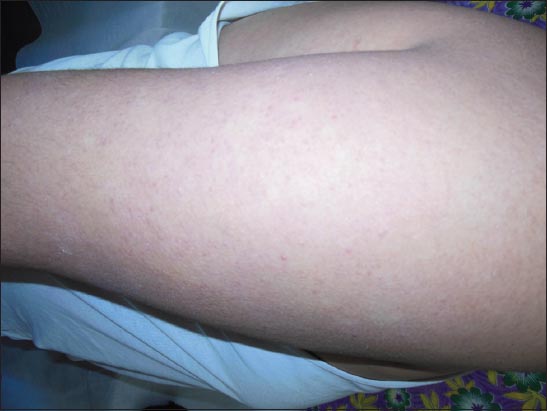Comparative study of efficacy of 30% Salicylic acid peel VsLong-pulsed 1064 nm Nd:YAG laser for treatment of Keratosis Pilaris
Zonunsanga
Department of Skin and VD, RNT Medical college, Udaipur, Rajasthan-313001, India.
ABSTRACT
Introduction: Keratosis pilaris(KP) is a disorder of keratinization of hair follicles characterized by keratin plugs in the hair follicles with perifollicular erythema. It may be inherited with X-Linked Dominant, or may be sporadic.
Aim of the study: to compare the efficacy of 30% Salicylic acid and Long pulsed 1064nm Nd:YAG laser for treatment of keratosis pilaris.
Materials and Methods: Out of 20 patients, 10 patients were given 30% Salicylic acid peel (after washing their face) every 15 days for 2 months. Another 15 patients were given the 1064 nm Nd:YAG Long pulse, Spot size: 10 mm, Pulse width: 30 ms every 4-6 weeks for 4 sitting.
Results: Among salicylic acid treated group, only 2 out of 10 showed improvement between 50-75%, and were slightly satisfied; none showed >75% improvement, and 8 out of 10 failed to show >50% improvement and were considered as failure of the therapy. Among the Nd:YAG treated group, 3 out of 10 showed 50-75% improvement and were slightly satisfied;none showed > 75% improvement, 7 out 10 failed to show successful results i.e. >50% improvement.
Conclusion: Both of the treatments are not much effective and do not give consistent and satisfactory results for treatment of keratosis pilaris.
Key words: Keratosis pilaris, Salicylic acid, Nd:YAG laser
INTRODUCTION
Keratosis pilaris (KP) is a disorder of keratinization of hair follicles characterized by keratin plugs in the hair follicles with perifollicular erythema. It may be inherited as X-Linked Dominant, or may be sporadic also. Familial type is often associated with icthysosis (mutation in filaggrin gene), or atopic dermatitis [1–3]. It may be due to translocation or deletion of chromosome 18. It is thought to be due to hyperkeratinization of hair follicles, which block the path for hairgrowth, thereby trapping the hair inside the follicles, which further leads to inflammation in the perifollicular areas. So, the histology shows the follicular orifice, distended by horny plug, which may be associated with mild inflammatory changes or inflammatory infiltrates in the dermis [1–3]. The usual sites affected are upper arms, thighs and buttocks, but it may involve face, trunk, or may be generalized also. The onset is usually childhood. It may be improved after puberty [1–3]. There might also be seasonal variation with winter aggravation due to dryness of skin [1–3]. Variants of keratosis pilaris include Keratosis pilaris rubra, Keratosis pilaris atrophicans faciei, Ulerythema ophryogenes – involvement of the outer eyebrow, Atrophoderma vermiculata, Keratosis follicularis spinulosa decalvans and Lichen spinulosus (keratosis spinulosa [1–3]). The current treatment includes Retinoids, Salicylic acid, and Laser in the form of Pulsed dye, IPL (intense pulse light) or Nd:YAG [4–9].
MATERIALS AND METHODS
The aim of the study is to compare the efficacy of 30% Salicylic acid and Long pulsed Nd:YAG laser for treatment of keratosis pilaris. The study was conducted at RNT Medical college and MB General Hospital, Udaipur, Rajasthan, between january 2012 to October 2014 (including the follow up period). The study was conducted under the approval from the ethics committee. 20 Patients with keratosis pilaris were enrolled in the study in which 10 patients were given 30% Salicylic acid peel and 10 patients were given Nd:YAG laser therapy. The inclusion criteria includes patients with KP, who had given consent for the therapy and the study; age between 15-30 years of age, as aging process starts at the age of 30 years, which may affect the treatment response, which will further cause bias during comparison; who had lesions in the arms, so that it will be more accurate to compare the effects in the same sites, as different sites may give different response which will again cause bias in the study. The exclusion criteria includes those patients who did not give consent; who had history of photosensitivity; age <15 years and > 30 years; those who had lesions at the sites other than arms. Those patients with salicylic acid treatment group were given 30% Salicylic acid peel (after washing their face) every 15 days for 2 months. Those patients under Nd:YAG laser treatment group were given the 1064 nm Nd:YAG Long pulse, Spot size:10 mm, Pulse width: 30 ms every 4-6 weeks for 4 sittings. Their eyes were protected with goggles during the laser treatment; and were advised to use sunscreen lotion to protect themselves from sunlight. Assessment: Photographs were taken prior to treatment (Figs. 1 and 3), and 2 months of follow up (i.e. 2 months after the last treatment) (Figs. 2 and 4), and were compared by 2 independent observers who were not involved in the study. Subjective Assessment Grading of improvement was done as follows: < 25% – poor, 25-<50%- fair, 50-<75%- good, >75%- very good. Degree of satisfaction at the end of the study was graded as: < 25% – Unsatisfied, 25-<50%- Slightly satisfied, 50-<75%- Satisfied, >75%- Very satisfied. < 50 % improvement was considered as failure of the therapy.
Ethics
This study was performed on human subjects; thus, all patients were aware of the presence of the study and they were fully informed about the drug and its side-effects.
Informed Consent: the patient’s informed consent was obtained. Prior to the study, every patient gave written consent to the examination.
RESULTS
20 patients were enrolled in the study, with 10 patients in each group. All of them were females. Age segregation was not done as the patients were randomly selected for each group. Regarding the subjective assessment results, among Salicylic acid treated group, only 2 out of 10 showed improvement between 50-75%, and were slightly satisfied; none showed >75% improvement, and 8 out of 10 failed to show >50% improvement and were considered as failure of the therapy. Among the Nd:YAG treated group, 3 out of 10 showed 50-75% improvement and were slightly satisfied,;none showed > 75% improvement, 7 out 10 failed to show successful results i.e. >50% improvement. There is no statistically significance between the results of the two groups.
DISCUSSION
Keratosis pilaris is the keratinization disorder of follicular epithelium in which the hair is trapped in the follicle due to hyperkeratinization of follicular epithelium [1–3]. Salicylic acid is a beta-Hydroxy acid, which is lipid soluble and can penetrate and reach the hair follicles. It has keratolytic property and removes the surface keratin from upper parts by exfoliating the keratin layer by layer, thereby removing the hyperkeratotic keratin. It also has antiinflammatory property by inhibiting COX enzymes, thereby decreasing production of the pro-inflammatory prostaglandins and leukotrienes [4]. Long pulse 1064nm Nd:YAG laser emits light waves, which target the chromophores in the skin, which are mainly Melanin in the hair and hair follicles. So, it selectively target the pigmented hair with the follicles, destroying them by the mechanism of photothermolysis as it generated heat at the target sites. It is better suited for fair skin as the darker skin has more melanin due to which more side effects can be seen with the laser therapy [5–9].
In this study, among Salicylic acid treated group, only 2 out of 10 showed improvement between 50-75%, and were slightly satisfied; none showed >75% improvement, and 8 out of 10 failed to show >50% improvement and were considered as failure of the therapy. Among the Nd:YAG treated group, 3 out of 10 showed 50-75% improvement and were slightly satisfied,;none showed > 75% improvement, 7 out 10 failed to show successful results i.e. >50% improvement. There is no statistically significance between the results of the two groups.
A pilot study was conducted by Saelim and his allies (Saelim et al, 2013) on Long-pulsed 1064-nm Nd:YAG laser for keratosis pilaris on Eighteen patients with untreated KP on the upper outer arms. One arm was treated with long-pulsed 1064-nm Nd:YAG laser at 30 msec pulse width and fluence of 34 J/cm2, while the contralateral arm served as control. Patients received three consecutive treatments at 4-week intervals. Three blinded dermatologists assessed digital photographs using a quartile grading system to separately rate global improvement, erythema and the number of keratotic papules. Seventeen patients completed the study. There were statistically significant improvements in global assessment, erythema and the number of keratotic papules at 4 weeks after the last treatment (p < 0.05). All patients also stated that their lesions improved and were satisfied with the laser treatment [7].
Another study was conducted by Kim S(Kim S 2011) on Treatment of pigmented keratosis pilaris in Asian patients with a novel Q-switched Nd:YAG laser. Ten patients with pigmented keratosis pilaris underwent five weekly treatments using a Q-switched Nd:YAG at 1064 nm with a 6-mm spot size and a fluence of 5.9 J/cm2. Photographic documentation was obtained at baseline and 2 months after the final treatment. Clinical improvement was achieved in all 10 patients with minimal adverse effects [8].
Another pilot study was done by Juhee Park, et al [9] to evaluate the effectiveness of the Q-switched 1064-nm Nd:YAG laser for the treatment of KP. Total of 12 patients with KP were treated with a Q-switched 1064-nm Nd:YAG laser. Ten sessions of laser treatment were delivered once every two weeks. The entire lesions were treated with the following laser settings: 4.0~5.0 J/cm2, 4-mm spot size, and three passes. Two dermatologists’ clinical evaluations and patients’ satisfaction were assessed between before treatment (baseline) and at 1 month after the last treatment. Eleven of the twelve patients showed more than grade 2 (>25%) improvement in texture and dyspigmentation in KP lesions, respectively. A half of the patients (50%) showed more than 50% improvement in the skin texture. Regarding dyspigmentation, five patients (41.7%) showed more than 50% improvement. Eleven out of twelve participants were satisfied (>25% of the Patients’ self assessment) with the procedure. No significant adverse effect was observed [9].
In this study, only 20% of salicylic acid treated group and only 30% of Long pulsed Nd:YAG treated group showed significant improvement (>50% improvement) with mild satisfaction.
CONCLUSION
In contrast to the theoretical mechanism of actions of Salicylic acid and Long pulsed Nd:YAG laser for treatment of keratosis pilaris, both of the treatments are not much effective and do not give consistent and satisfactory results for treatment of keratosis pilaris. Both treatments did not give signifcant difference in their efficacy.
CONSENT
The examination of the patient was conducted according to the Declaration of Helsinki principles. Written informed consent was obtained from the patient for publication of this article. A copy of all documents available for review by the Editor-in-Chief of this journal.
REFERENCES
1. Hwang S, Schwartz RA, Keratosis pilaris: a common follicular hyperkeratosisCutis 2008; 82: 177-80.
2. Alai Nili, “Keratosis Pilaris (KP)”Medicine Net Retrieved 2008-10-06
3. Berman Kevin, “Keratosis pilaris”Medline Plus Retrieved 2008-06-19
4. Roberts WE, Chemical peeling in ethnic/dark skinDermatol Ther 2004; 17: 196-205.
5. Kaune KM, Haas E, Emmert S, Schon MP, Zutt M, Successful treatment of severe keratosis pilaris rubra with a 595-nm pulsed dye laserDermatol Surg 2009; 35: 1592-5.
6. Clark SM, Mills CM, Lanigan SW, Treatment of keratosis pilaris atrophicans with the pulsed tunable dye laserJ Cutan Laser Ther 2000; 2: 151-6.
7. Saelim P, Pongprutthipan M, Pootongkam S, Jariyasethavong V, Asawanonda P, Long-pulsed. 1064-nm Nd: YAG laser significantly improves keratosis pilaris: a randomized, evaluator-blind studyJ Dermatolog Treat 2013; 24: 318-22.
8. Kim S, Treatment of pigmented keratosis pilaris in Asian patients with a novel Q-switched Nd: YAG laserJ Cosmet Laser Ther 2011; 13: 120-2.
9. Park J, Kim BJ, Kim MN, Lee CK, A Pilot Study of Q-switched 1064-nm Nd: YAG Laser Treatment in the Keratosis PilarisAnn Dermatol 2011; 23: 293-8.
Notes
Source of Support: Nil
Conflict of Interest: None declared.




Comments are closed.